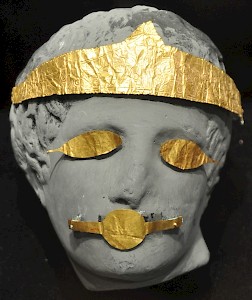Phocaea
Q428732Phocaea (Φώκαια): Greek city in Ionia, modern Foça in western Turkey.

Phocaea was the most northerly of the Ionian settlements on the eastern shores of the Aegean Sea. It was situated on the border with the Aeolian region.
The city, which dates back to the Bronze Age, was believed to have been founded people from Phocis in mainland Greece.note This may be nothing more than a legend, based on the similarity of the names.
However this may be, during the Archaic Age, Phocaeans were famed as navigators. Their merchants took part in the Ionian trade with Naucratis in Egypt and, in association with Miletus, they set up Lampsacus at the northern entrance to the Hellespont and Amisus (Samsun) on the Black Sea. In the west, Phocaeans founded Velia, Aleria (on Corsica), Nicaea (modern Nice), and Massalia. They also had trade contacts with Tartessus in Andalusia. A sign of their wealth is their city wall, with a length of some five kilometers, built in c.585 BCE.
After the conquest of Anatolia by the Persians and the fall of the Lydian capital Sardes (perhaps in 547 BCE), Phocaea was captured by general Harpagus.note The inhabitants sailed away to the west, to Corsica, where they were defeated by the Etruscans. Some survivors may have reached Catalonia, where they may have founded the "new town" of Emporiae.
A newly occupied Phocaea joined the Ionian Insurrection against Persia;note after the Persian Wars, the city became a member of the Athenian alliance, the Delian League. Thucydides mentions that in 412, the city revolted and left the Delian League.note

During the reign of Alexander the Great, the theater was built. During the Hellenistic period, Phocaea was ruled first by the Seleucids and then by the Attalids of Pergamon. In 132 BCE, it participated in Aristonicus' uprising against the Romans, but the town was saved from destruction by the Massalians, who were allies of Rome.note
In ancient times there was a temple, dedicated to Athena. Nowadays almost nothing is left of it. Among the other deities venerated in Phocaea was Cybele.

A rock-cut tomb rising to the north of the road leading to Menemen, seven kilometers east of Foça, is connected with indigenous Anatolian tradition. The monument is 4½ meters high and was not built as a separate edifice but was carved out of the rock, like the tombs found in Lycia, Lydia and Phrygia. The monument follows the Lycian custom of having two storeys, with the upper one built in the form of a sarcophagus. In contrast to the archaic Lycian custom, the burial chamber was on the ground floor. The presence of a stepped part between the two floors is indicative of Achaemenid influence. This building must therefore have been erected in memory of a minor king during a time when non-democratic Persian rulers dominated the region. The tomb is well preserved and can be visited without a problem.